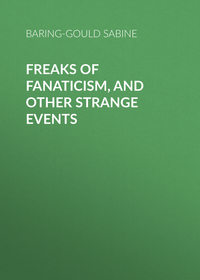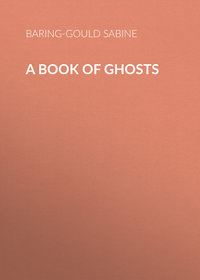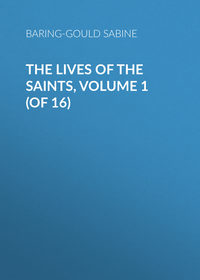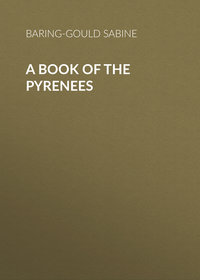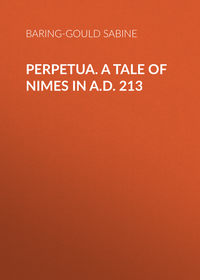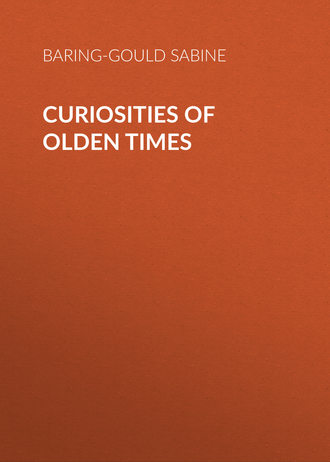 полная версия
полная версияCuriosities of Olden Times

S. Baring-Gould
Curiosities of Olden Times
An antiquary lights on many a curiosity whilst overhauling the dusty tomes of ancient writers. This little book is a small museum in which I have preserved some of the quaintest relics which have attracted my notice during my labours. The majority of the articles were published in 1869. I have now added some others.
Lew Trenchard,
September 1895.
THE MEANING OF MOURNING
A strip of black cloth an inch and a half in width stitched round the sleeve – that is the final, or perhaps penultimate expression (for it may dwindle further to a black thread) of the usage of wearing mourning on the decease of a relative.
The usage is one that commends itself to us as an outward and visible sign of the inward sentiment of bereavement, and not one in ten thousand who adopt mourning has any idea that it ever possessed a signification of another sort. And yet the correlations of general custom – of mourning fashions, lead us to the inexorable conclusion that in its inception the practice had quite a different signification from that now attributed to it, nay more, that it is solely because its primitive meaning has been absolutely forgotten, and an entirely novel significance given to it, that mourning is still employed after a death.
Look back through the telescope of anthropology at our primitive ancestors in their naked savagery, and we see them daub themselves with soot mingled with tallow. When the savage assumed clothes and became a civilised man, he replaced the fat and lampblack with black cloth, and this black cloth has descended to us in the nineteenth century as the customary and intelligible trappings of woe.
The Chinaman when in a condition of bereavement assumes white garments, and we may be pretty certain that his barbarous ancestor, like the Andaman Islander of the present day, pipeclayed his naked body after the decease and funeral of a relative. In Egypt yellow was the symbol of sorrow for a death, and that points back to the ancestral nude Egyptian having smeared himself with yellow ochre.
Black was not the universal hue of mourning in Europe. In Castile white obtained on the death of its princes. Herrera states that the last time white was thus employed was in 1498, on the death of Prince John. This use of white in Castile indicates chalk or pipeclay as the daub affected by the ancestors of the house of Castile in primeval time as a badge of bereavement.
Various explanations have been offered to account for the variance of colour. White has been supposed to denote purity; and to this day white gloves and hat-bands and scarves are employed at the funeral of a young girl, as in the old ballad of “The Bride’s Burial”: —
A garland fresh and fairOf lilies there was made,In signs of her virginity,And on her coffin laid.Six pretty maidens, all in white,Did bear her to the ground,The bells did ring in solemn swingAnd made a doleful sound.Yellow has been supposed to symbolise that death is the end of human hopes, because falling leaves are sere; black is taken as the privation of light; and purple or violet also affected as a blending of joy with sorrow. Christian moralists have declaimed against black as heathen, as denoting an aspect of death devoid of hope, and gradually purple is taking its place in the trappings of the hearse, if not of the mourners, and the pall is now very generally violet.
But these explanations are afterthoughts, and an attempt to give reason for the divergence of usage which might satisfy, but these are really no explanations at all. The usage goes back to a period when there were no such refinements of thought. If violet or purple has been traditional, it is so merely because the ancestral Briton stained himself with woad on the death of a relative.
The pipeclay, lampblack, yellow ochre, and woad of the primeval mourners must be brought into range with a whole series of other mourning usages, and then the result is something of an “eye-opener.” It reveals a condition of mind and an aspect of death that causes not a little surprise and amusement. It is one of the most astonishing, and, perhaps, shocking traits of barbarous life, that death revolutionises completely the feelings of the survivors towards their deceased husbands, wives, parents, and other relatives.
A married couple may have been sincerely attached to each other so long as the vital spark was twinkling, but the moment it is extinguished the dead partner becomes, not a sadly sweet reminiscence, but an object of the liveliest terror to the survivor. He or she does everything that ingenuity can suggest to get him or herself out of all association in body and spirit with the late lamented. Death is held to be thoroughly demoralising to the deceased. However exemplary a person he or she may have been in life, after death the ghost is little less than a plaguing, spiteful spirit.
There is in the savage no tender clinging to the remembrance of the loved one, he is translated into a terrible bugbear, who must be evaded and avoided by every contrivance conceivable. This is due, doubtless, mainly to the inability of the uncultivated mind to discriminate between what is seen waking from what presents itself in phantasy to the dreaming head. After a funeral, it is natural enough for the mourners to dream of the dead, and they at once conclude that they have been visited by his revenant. After a funeral feast, a great gorging of pork or beef, it is very natural that the sense of oppression and pain felt should be associated with the dear departed, and should translate itself into the idea that he has come from his grave to sit on the chests of those who have bewailed him.
Moreover, the savage associates the idea of desolation, death, discomfort, with the condition of the soul after death, and believes that the ghosts do all they can to return to their former haunts and associates for the sake of the warmth and food, the shelter of the huts, and the entertainment of the society of their fellows. But the living men and women are not at all eager to receive the ghosts into the family circle, and they accordingly adopt all kinds of “dodges,” expedients to prevent the departed from making these irksome and undesired visits.
The Venerable Bede tells us that Laurence, Archbishop of Canterbury, resolved on flying from England because he was hopeless of effecting any good under the successor of Ethelbert, king of Kent. The night before he fled he slept on the floor of the church, and dreamed that St. Peter cudgelled him soundly for resolving to abandon his sacred charge. In the morning he awoke stiff and full of aches and pains. Turned into modern language, we should say that Archbishop Laurence was attacked with rheumatism on account of his having slept on the cold stones of the church. His mind had been troubled before he went to sleep with doubts whether he were doing right in abandoning his duty, and very naturally this trouble of conscience coloured his dream, and gave to his rheumatic twinges the complexion it assumed.
Now Archbishop Laurence regarded the Prince of the Apostles in precisely the light in which a savage views his deceased relatives and ancestors. He associates his maladies, his pains, with theirs, if he should happen to dream of them. If, however, when in pain, he dreams of a living person, then he holds that this living person has cast a magical spell over him.
Among nature’s men, before they have gone through the mill of civilisation, plenty to eat and to drink, and some one to talk to, are the essentials of happiness. They see that the dead have none of these requisites, they consider that they are miserable without them. The writer remembers how, when he was a boy, and attended a funeral of a relative in November, he could not sleep all night – a bitter, frosty night – with the thought how cold it must be to the dead in the vault, without blankets, hot bottle, or fire. It was in vain for him to reason against the feeling; the feeling was so strong on him that he was conscious of an uncomfortable expectation of the dead coming to claim a share of the blanket, fire, or hot bottle. Now the savage never reasons against such a feeling, and he assumes that the dead will return, as a matter of course, for what he cannot have in the grave.
The ghost is very anxious to assert its former rights. A widow has to get rid of the ghost of her first husband before she can marry again. In Parma a widow about to be remarried is pelted with sticks and stones, not in the least because the Parmans object to remarriage, but in order to scare away the ghost of No. 1, who is hanging about his wife, and who will resent his displacement in her affections by No. 2.
To the present day, in some of the villages of the ancient Duchy of Teck, in Würtemberg, it is customary when a corpse is being conveyed to the cemetery, for relatives and friends to surround the dead, and in turn talk to it – assure it what a blessed rest it is going to, how anxious the kinsfolk are that it may be comfortable, how handsome will be the cross set over the grave, how much all desire that it may sleep soundly and not by any means leave the grave and come haunting old scenes and friends, how unreasonable such conduct as the latter hinted at would be, how it would alter the regard entertained for the deceased, how disrespectful to the Almighty who gives rest to the good, and how it would be regarded as an admission of an uneasy conscience. Lively comparisons are drawn between the joys of Paradise and the vale of tears that has been quitted, so as to take away from the deceased all desire to return.
This is a survival of primitive usage and mode of thought, and has its analogies in many places and among diverse races.
The Dacotah Indians address the ghost of the dead in the same “soft solder,” to induce it to take the road to the world of spirits and not to come sauntering back to its wigwam. In Siam and in China it is much the same; persuasion, flattery, threats are employed.
Unhappily all ghosts are not open to persuasion, and see through the designs of the mourners, and with them severer measures have to be resorted to. Among the Sclavs of the Danube and the Czechs, the bereaved, after the funeral, on going home turn themselves about after every few steps and throw sticks, stones, mud, even hot coals in the direction of the churchyard, so as to frighten the spirit back to the grave so considerately provided for it. A Finnish tribe has not even the decency to wait till the corpse is covered with soil; they fire pistols and guns after it as it goes to its grave, and lies in it.
In Hamlet, at the funeral of Ophelia, the priest says —
For charitable prayers,Shards, flints, and pebbles should be thrown on her.Unquestionably it must have been customary in England thus to pelt a ghost that was suspected of the intention to wander. The stake driven through the suicide’s body was a summary and complete way of ensuring that the ghost would not be troublesome.
Those Finns who fired guns after a dead man had another expedient for holding him fast, and that was to nail him down in his coffin. The Arabs tie his legs together. The Wallacks drive a long nail through the skull; and this usage explains the many skulls that have been exhumed in Germany thus perforated. The Icelanders, when a ghost proved troublesome, opened the grave, cut off the dead man’s head, and made the body sit on it. That, they concluded, would effectually puzzle it how to get about. The Californian Indians were wont to break the spine of the corpse so as to paralyse his lower limbs, and make “walking” impossible. Spirit and body to the unreasoning mind are intimately associated. A hurt done to the body wounds the soul. Mrs. Crowe, in her Night Side of Nature, tells a story reversing this. A gentleman in Germany was dying – he expressed great desire to see his son, who was a ne’er-do-well, and was squandering his money in Paris. At that same time the young man was sitting on a bench in the Bois de Boulogne, with a switch in his hand. Suddenly he saw his old father before him. Convinced that he saw a phantom, he raised his switch, and cut the apparition once, twice, and thrice across the face; and it vanished. At that moment the dying father uttered a scream, and held his hands to his face – “My boy! my boy! He is striking me again – again!” and he died. The Algonquin Indians beat the walls of the death-chamber to drive out the ghost; in Sumatra, a priest is employed with a broom to sweep the ghost out. In Scotland, and in North Germany, the chairs on which a coffin has rested are reversed, lest the dead man should take the fancy to sit on them instead of going to his grave. In ancient Mexico, certain professional ghost ejectors were employed, who, after a funeral, were invited to visit and thoroughly explore the house whence the dead had been removed, and if they found the ghost lurking about, in corners, in cupboards, under beds – anywhere, to kick it out. In Siberia, after forty days’ “law” given to the ghost, if it be still found loafing about, the Schaman is sent for, who drums it out. He extorts brandy, which he professes to require, as he has to conduct the deceased personally to the land of spirits, where he will make it and the other guests so fuddled that they will forget the way back to earth.
In North Germany a troublesome ghost is bagged, and the bag emptied in some lone spot, or in the garden of a neighbour against whom a grudge is entertained.
Another mode of getting rid of the spirit of the dear departed is to confuse it as to its way home. This is done in various ways. Sometimes the road by which it has been carried to its resting-place is swept to efface the footprints, and a false track is made into a wood or on to a moor, so that the ghost may take the wrong road. Sometimes ashes are strewn on the road to hide the footprints. Sometimes the dead is carried rapidly three or four times round the house so as to make him giddy, and not know in which direction he is carried. The universal practice of closing the eyes of the dead may be thought to have originated in the desire that he might be prevented from seeing his way.
In many places it was, and is, customary for the dead body to be taken out of the house, not through the door, but by a hole knocked in the wall for the purpose, and backwards. In Iceland in the historic period this custom was reserved for such as died in their seats and not in their beds. One or two instances occur in the Sagas. In Corea, blinders made of black silk are put on the dead man’s eyes, to prevent him from finding his way home.
Many savage nations entirely abandon a hut or a camp in which a death has occurred for precisely the same reason – of throwing out the dead man’s spirit.
It was a common practice in England till quite recently for the room in which a death had occurred to be closed for some time, and this is merely a survival of the custom of abandoning the place where a spirit has left the body. The Esquimaux take out their dying relatives to huts constructed of blocks of ice or snow, and leave them there to expire, for ghosts are as stupid as they are troublesome, they have no more wits than a peacock, they can only find their way to the place where they died.
Other usages are to divert a stream and bring the corpse in the river-bed, or lay it beyond running water, which according to ghost-lore it cannot pass. Or again, fires are lighted across its path, and it shrinks from passing through flames. As for water, ghosts loathe it. Among the Matamba negroes a widow is flung into the water and dipped repeatedly so as to wash off the ghost of the dead husband, which is supposed to be clinging to her. In New Zealand, among the Maoris, all who have followed the corpse dive into water so as to throw off the ghost which is sneaking home after them. In Tahiti, all who have assisted at a burial run as hard as they can to the sea and take headers into it for the same object. It is the same in New Guinea. We see the same idea reduced to a mere form in ancient Rome, where in place of the dive through water, a vessel of water was carried twice round those who had followed the corpse, and they were sprinkled. The custom of washing and purification after a funeral practised by the Jews is a reminiscence of the usage, with a novel explanation given to it.
In the South Pacific, in the Hervey Islands, after a death men turn out to pummel and fight the returning spirit, and give it a good drubbing in the air.
Now, perhaps, the reader may have been brought to understand what the sundry mourning costumes originally meant. They were disguises whereby to deceive the ghosts, so that they might not recognise and pester with their undesired attentions the relatives who live. Indians who are wont to paint themselves habitually, go after a funeral totally unbedecked with colour. On the other hand, other savages daub themselves fantastically with various colours, making themselves as unlike what they were previously as is possible. The Coreans when in mourning assume hats with low rims that conceal their features.
The Papuans conceal themselves under extinguishers made of banana leaves. Elsewhere in New Guinea they envelop themselves in a wickerwork frame in which they can hardly walk. Among the Mpongues of Western Africa, those who on ordinary occasions wear garments walk in complete nudity when suffering bereavement. Valerius Maximus tells us that among the Lycians it was customary in mourning for the men to disguise themselves in women’s garments.
The custom of cutting the hair short, and of scratching and disfiguring the face, and of rending the garments, all originated from the same thought – to make the survivors irrecognisable by the ghost of the deceased. Plutarch asserts that the Sacæ, after a death, went down into pits and hid themselves for days from the light of the sun. Australian widows near the north-west bend of the Murray shave their heads and plaster them with pipeclay, which, when dry, forms a close-fitting skull-cap. The spirit of the late lamented on returning to his better half either does not recognise his spouse, or is so disgusted with her appearance that he leaves her for ever.
There is almost no end to the expedients adopted for getting rid of the dead. Piles of stones are heaped over them, they are buried deep in the earth, they are walled up in natural caves, they are enclosed in megalithic structures, they are burned, they are sunk in the sea. They are threatened, they are cajoled, they are hoodwinked. Every sort of trickery is had recourse to, to throw them off the scent of home and of their living relations.
The wives, horses, dogs slain and buried with them, the copious supplies of food and drink laid on their graves, are bribes to induce them to be content with their situation. Nay, further – in very many places no food may be eaten in the house of mourning for many days after an interment. The object of course is to disappoint the returning spirit, which comes seeking a meal, finds none, comes again next day, finds none again, and after a while desists from returning out of sheer disgust.
A vast amount of misdirected ingenuity is expended in bamboozling and bullying the unhappy ghosts; but the feature most striking in these proceedings is the unanimous agreement in considering these ghosts as such imbeciles. When they put off their outward husk, they divest themselves of all that cunning which is the form that intelligence takes in the savage. Not only so, but although they remember and crave after home comforts, they absolutely forget the tricks they had themselves played on the souls of the dead in their own lifetime; they walk and blunder into the traps which they had themselves laid for other ghosts in the days of their flesh.
Perhaps the lowest abyss of dunder-headedness they have been supposed to reach is when made to mistake their own identity. Recently near Mentone a series of prehistoric interments in caves have been exposed. They reveal the dead men as having had their heads daubed over with red oxide of iron. Still extant races of savages paint, plaster, and disfigure their dead. The prehistoric Greeks masked them. The Aztecs masked their deceased kings, and the Siamese do so still. We cannot say with absolute certainty what the object is – but we are probably not far out when we conjecture the purpose to be to make the dead forget who they are when they look at their reflection in the water. There was a favourite song sung some sixty years ago relative to a little old woman who got “muzzy.” Whilst in this condition some naughty boys cut her skirts at her knees. When she woke up and saw her condition, “Lawk!” said the little old woman, “this never is me!” And certain ancient peoples treated their dead in something the same way; they disguised and disfigured them so that each ghost waking up might exclaim, “Lawk! this never is me!” And so having lost its identity, did not consider it had a right to revisit its old home and molest its old acquaintances.
CURIOSITIES OF CYPHER
In 1680, when M. de Louvois was French Minister of War, he summoned before him one day a gentleman named Chamilly, and gave him the following instructions:
“Start this evening for Basle, in Switzerland; you will reach it in three days; on the fourth, punctually at two o’clock, station yourself on the bridge over the Rhine, with a portfolio, ink, and a pen. Watch all that takes place, and make a memorandum of every particular. Continue doing so for two hours; have a carriage and post-horses awaiting you;, and at four precisely mount, and travel night and day till you reach Paris. On the instant of your arrival, hasten to me with your notes.”
De Chamilly obeyed; he reached Basle, and on the day and at the hour appointed, stationed himself, pen in hand, on the bridge. Presently a market-cart drives by; then an old woman with a basket of fruit passes; anon, a little urchin trundles his hoop by; next an old gentleman in blue top-coat jogs past on his gray mare. Three o’clock chimes from the cathedral tower. Just at the last stroke, a tall fellow in yellow waistcoat and breeches saunters up, goes to the middle of the bridge, lounges over, and looks at the water; then he takes a step back and strikes three hearty blows on the footway with his staff. Down goes every detail in De Chamilly’s book. At last the hour of release sounds, and he jumps into his carriage. Shortly before midnight, after two days of ceaseless travelling, De Chamilly presented himself before the minister, feeling rather ashamed at having such trifles to record. M. de Louvois took the portfolio with eagerness, and glanced over the notes. As his eye caught the mention of the yellow-breeched man, a gleam of joy flashed across his countenance. He rushed to the king, roused him from sleep, spoke in private with him for a few moments, and then four couriers who had been held in readiness since five on the preceding evening were despatched with haste. Eight days after, the town of Strasbourg was entirely surrounded by French troops, and summoned to surrender: it capitulated and threw open its gates on the 30th of September 1681. Evidently the three strokes of the stick given by the fellow in yellow costume, at an appointed hour, were the signal of the success of an intrigue concerted between M. de Louvois and the magistrates of Strasbourg, and the man who executed this mission was as ignorant of the motive as was M. de Chamilly of the motive of his.
Now this is a specimen of the safest of all secret communications, but it can only be resorted to on certain rare occasions. When a lengthy despatch is required to be forwarded, and when such means as those given above are out of the question, some other method must be employed. Herodotus gives us a story to the point: it is found also, with variations, in Aulus Gellius.
“Histiæus, when he was anxious to give Aristagoras orders to revolt, could find but one safe way, as the roads were guarded, of making his wishes known: which was by taking the trustiest of his slaves, shaving all the hair from off his head, and then pricking letters upon the skin, and waiting till the hair grew again. This accordingly he did; and as soon as ever the hair was grown, he despatched the man to Miletus, giving him no other message than this: ‘When thou art come to Miletus, bid Aristagoras shave thy head, and look thereon.’ Now the marks on the head were a command to revolt.” – Bk. v. 35.





